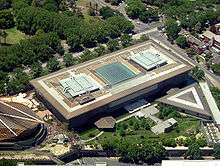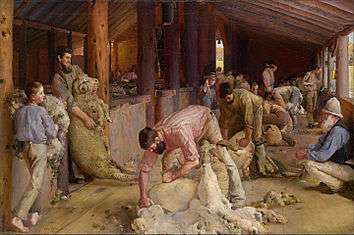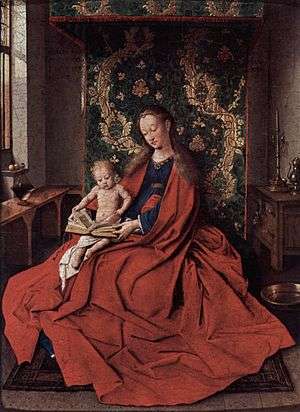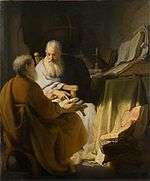National Gallery of Victoria
 | |
| Established | 1861 |
|---|---|
| Location | Southbank, Melbourne, Australia |
| Coordinates | 37°49′21″S 144°58′07″E / 37.822595°S 144.968634°E |
| Type | Art museum |
| Visitors | 2,600,000 (2015) |
| Director | Tony Ellwood |
| Public transit access |
Flinders Street Station Tram routes 1, 3, 5, 6, 8, 16, 64, 67, 72 |
| Website | http://www.ngv.vic.gov.au |
The National Gallery of Victoria, popularly known as the NGV, is an art museum in Melbourne, Australia. Founded in 1861, it is Australia's oldest, largest and most visited art museum.
The National Gallery of Victoria houses an encyclopedic art collection across two sites: NGV International, located on St Kilda Road in the Melbourne Arts Precinct of Southbank, and the Ian Potter Centre: NGV Australia, located nearby at Federation Square. The St Kilda Road building, designed by Sir Roy Grounds, opened in 1968, and was redeveloped by Mario Bellini before reopening in 2003. It houses the gallery's international art collection and is on the Victorian Heritage Register. Designed by Lab Architecture Studio, the Ian Potter Centre opened in 2002 and houses the gallery's Australian art collection.
History

Victoria gained independence from New South Wales in 1850, and in the wake of the Victorian gold rush that almost immediately followed, it became the richest colony in Australia, and Melbourne, its capital city, the largest and wealthiest city in Australia. In 1859, the Government of Victoria pledged £2000 for the purchase of plaster casts of sculpture, which were first exhibited on the lower floor of the south wing of the Public Library on Swanston Street on 24 May 1861.[1] Further money was set aside in the early 1860s for the establishment of the first "National Gallery". Grand visions for a gallery building at Lonsdale and Swanston Street were drawn by Nicholas Chevalier in 1860 and Frederick Grosse in 1865 featuring an enormous and elaborate library and gallery, however such visions were never realised.
.jpg)
On 24 May 1874, the first purpose built gallery, known as the McArthur Gallery, was opened in the McArthur room of the State Library.[1] The "undressed box" was only ever intended as a temporary home until the much grander vision was to be realised.[2] However such an edifice did not eventuate and the complex was instead developed incrementally over several decades.
The National Gallery of Victoria Art School, associated with the gallery, was founded in 1867 and remained the leading centre for academic art training in Australia until about 1910.[3] The School's graduates went on to become some of Australia's most significant artists.
In 1887, the Buvelot Gallery (later Swinburne Hall) was opened, along with the Painting School studios. In 1892, two more galleries were added: Stawell (now Cowen) and La Trobe.[1]
The gallery's collection was built from both gifts of works of art and monetary donations. The most significant, the Felton Bequest, was established by the will of Alfred Felton and from 1904, has been used to purchase over 15,000 works of art.[4]
Since the Felton Bequest, the gallery had long held plans to build a permanent facility, however it was not until 1943 that the State Government chose a site, Wirth's Park, just south of the Yarra River.[5] £3 million was put forward in February 1960 and Roy Grounds was announced as the architect.[6]
In 1962, Roy Grounds split from his partners Frederick Romberg and Robin Boyd, retained the commission, and designed the gallery at 180 St Kilda Road. By 1967, the new $14 million complex began to take shape.[7] and the gallery was finally relocated to the new building in the summer of 1967-1968.[1] The new bluestone clad building was officially opened on Tuesday 20 August 1968 by Victorian premier Henry Bolte.[8]
In 1999, redevelopment of the building was proposed, with Mario Bellini chosen as architect and an estimated project cost of $161.9 million. The proposal was to leave the original architectural fabric intact including the exterior facade and Leonard French stained glass ceiling, but to significantly modernise the spaces.[9] During the redevelopment, many works were moved to a temporary external annex known as 'NGV on Russell', at the State Library with its entrance on Russell Street.[1]
A major fundraising drive was launched on 10 October 2000 to redevelop the ageing facility and although the state government committed the majority of the funds, private donations were sought in addition to federal funding. The drive achieved its aim and secured $15 million from the Ian Potter Foundation on 11 July 2000, $3 million from Lotti Smorgon, $2 million from the Clemenger Foundation, and $1 million each from James Fairfax and the Pratt Foundation.[10]
NGV on Russell closed on 30 June 2002[1] to make way for the staged opening of the new St Kilda Road gallery and the new gallery was officially opened on 4 December 2003 by premier Steve Bracks.[11]
The Ian Potter Centre: NGV Australia was designed by Lab Architecture Studio and opened in 2002.
Australian collection

The NGV's Australian art collection encompasses Indigenous (Australian Aboriginal) art and artefacts, Australian colonial art, Australian Impressionist art, 20th century, modern and contemporary art.
In the late 19th and early 20th century, domestic art began to thrive (particularly with the Heidelberg School in what was then an outer suburb of Melbourne) and the NGV was well-placed to add an excellent collection of key Australian works, which trace the metamorphosis of imported European styles into distinctively Australian art. The NGV houses many of the most recognisable Australian paintings, including Frederick McCubbin's The Pioneer and Tom Roberts' Shearing the Rams.
The Australian collection includes works by Charles Blackman, John Brack, Arthur Boyd, Louis Buvelot, Rupert Bunny, Nicholas Chevalier, Charles Conder, David Davies, William Dobell, Russell Drysdale, E. Phillips Fox, John Glover, Eugene von Guerard, Hans Heysen, George W. Lambert, Sydney Long, John Longstaff, Frederick McCubbin, Sidney Nolan, John Perceval, Margaret Preston, Hugh Ramsay, Tom Roberts, John Russell, Grace Cossington Smith, Arthur Streeton, Fred Williams and others.
A large number of works were donated by Dr. Joseph Brown in 2004 which form the Joseph Brown Collection.
Gallery
 Aboriginal shields
Aboriginal shields Tom Roberts, Shearing the Rams, 1890
Tom Roberts, Shearing the Rams, 1890 Arthur Streeton, ‘The purple noon's transparent might’, 1896
Arthur Streeton, ‘The purple noon's transparent might’, 1896 Frederick McCubbin, The Pioneer, 1904
Frederick McCubbin, The Pioneer, 1904
International collection

The NGV's international art collection encompasses European and international paintings, fashion and textiles, photography, prints and drawings, Asian art, decorative arts, Mesoamerican art, Pacific art, sculpture, antiquities and global contemporary art. It has strong collections in areas as diverse as old masters, Greek vases, Egyptian artefacts and historical European ceramics, and contains the largest and most comprehensive range of artworks in Australia.[12]
The international collection includes works by Bernini, Bordone, Canaletto, Cézanne, Constable, Correggio, Degas, van Dyck, Gainsborough, Gentileschi, El Greco, Manet, Memling, Modigliani, Monet, Picasso, Pissarro, Poussin, Rembrandt, Renoir, Ribera, Rodin, Rothko, Rubens, Tiepolo, Giambattista Pittoni, Tintoretto, Turner, Uccello, Veronese and others.
In 2011 the NGV celebrated its 150th birthday and acquired an important painting by Correggio.
Gallery

 Hans Memling, The Man of Sorrows in the arms of the Virgin, 1475
Hans Memling, The Man of Sorrows in the arms of the Virgin, 1475 Antonio da Correggio, Madonna and Child with infant St John the Baptist, 1514–15
Antonio da Correggio, Madonna and Child with infant St John the Baptist, 1514–15 Jacopo Tintoretto, Doge Pietro Loredano, 1567–70
Jacopo Tintoretto, Doge Pietro Loredano, 1567–70 Rembrandt, Two old men disputing, 1628
Rembrandt, Two old men disputing, 1628
 Anthony van Dyck, Rachel de Ruvigny, Countess of Southampton, 1640
Anthony van Dyck, Rachel de Ruvigny, Countess of Southampton, 1640
 Thomas Gainsborough, An officer of the 4th Regiment of Foot, 1776
Thomas Gainsborough, An officer of the 4th Regiment of Foot, 1776 Jules Bastien-Lepage, October, 1878
Jules Bastien-Lepage, October, 1878.jpg) Claude Monet, Vétheuil, 1879
Claude Monet, Vétheuil, 1879 Camille Pissarro, Boulevard Montmartre, morning, cloudy weather, 1897
Camille Pissarro, Boulevard Montmartre, morning, cloudy weather, 1897
Photography collection
In 1967, the NGV established the first curatorial department dedicated to photography in an Australian public gallery,[13] one of the first in the world. It now holds over 15,000 works. In that same year, the Gallery acquired the photography collection's first work, Surrey Hills street 1948 by David Moore and in 1969 the first international work was acquired, Nude 1939 by František Drtikol. The first photographer to exhibit solo at the NGV was Mark Strizic in 1968[14]. Jennie Boddington, a filmmaker, was appointed first full-time curator of photography[15] in 1972,[16] possibly only the third such appointment amongst world public institutions.
As a "National Gallery"
.jpg)
For some people the name "National Gallery of Victoria" is contentious as it is sometimes confused with the National Gallery of Australia (NGA) in Canberra, and there have been calls for the NGV to be renamed. However, the NGV was founded some 40 years before the formation of the Commonwealth of Australia, when Victoria was a self-governing British colony and a discrete political entity. It was also established more than a century before the NGA. According to former Victorian Premier Steve Bracks, "We won't be renaming the National Gallery of Victoria. It has a great tradition. It is the biggest and best gallery in the country and it's one of the biggest and best in the world."
Ian Potter Centre and NGV International
In 1959, the commission to design a new gallery and cultural centre was awarded to the architectural firm Grounds Romberg Boyd. In 1962, Roy Grounds split from his partners Frederick Romberg and Robin Boyd, retained the commission, and designed the gallery at 180 St Kilda Road (now known as NGV International). The building was completed in December 1967[18] and opened on 20 August 1968. One of the features of the building is the Leonard French stained glass ceiling, one of the world's largest pieces of suspended stained glass, which casts colourful light on the floor below. The water-wall entrance is another well-known feature of the building. Grounds subsequently designed the adjacent Victorian Arts Centre with its iconic spire.
The NGV is now spread over two buildings a short distance from each other at the southern end of the CBD. The Ian Potter Centre: NGV Australia, in Federation Square opened in 2003 and houses the Australian art collection. Grounds' building, just south of the Yarra River, houses the international collection. It reopened in December 2003 after four years of renovations by architect Mario Bellini. The iconic Angel sculpture by Deborah Halpern was restored and was relocated to Birrarung Marr.
Picasso theft
A famous event in the history of the gallery was the theft of Pablo Picasso's painting The Weeping Woman in 1986 during the tenure of director Patrick McCaughey. A person or group who identified themselves as the "Australian Cultural Terrorists" claimed responsibility for the removal of the painting in protest against the perceived poor treatment of the arts by the state government of the time. They sought as a ransom the establishment of an art prize for young artists. The painting was returned in a railway locker two weeks later.[19]
Melbourne Winter Masterpieces
The National Gallery of Victoria has held several large exhibitions known as Melbourne Winter Masterpieces exhibitions, starting with Impressionists: Masterpieces from the Musee d'Orsay in 2004, and an exhibition of Dutch masters in winter 2005 with Vermeer's painting The Love Letter from the Rijksmuseum in Amsterdam exhibited among many others. It was the first time a Vermeer painting had been exhibited in Australia. There was also an exhibition of Caravaggio paintings in 2004.
The 2006 Melbourne Winter Masterpieces exhibition was titled Picasso: Love and War 1935–1945 and ran from 30 June 2006 and 8 October 2006. The exhibition of over 300 Picasso drawings and paintings from the years 1935–1945 was curated by Anne Baldassari, Director of the Musée Picasso, Paris.[20]
The 2007 Melbourne Winter Masterpieces exhibition was titled "Guggenheim Collection 1940s to now" (30 June to 7 October 2007) and showed more than 85 works by 68 artists, mainly from the Solomon R. Guggenheim Museum, New York City, but also from other Guggenheim Museums in Venice, Bilbao, and Berlin. The exhibition did not travel to any other city; it was seen by more than 180,000 visitors.[21][22]
The 2008 Melbourne Winter Masterpieces exhibition was titled "Art Deco 1910—1939" and ran from 28 June to 5 October 2008. The exhibition was organized by the Victoria and Albert Museum, London.[23]
The 2009 Melbourne Winter Masterpieces exhibition was titled "Salvador Dalí Liquid Desire" and ran from 13 June to 4 October 2009.[24]
The 2010 Melbourne Winter Masterpieces exhibition was "European Masters: Städel Museum, 19th–20th Century".
The 2011 Melbourne Winter Masterpieces exhibition was titled "Vienna Art and Design" and ran from 13 June to 4 October 2011.[25]
The 2012 Melbourne Winter Masterpieces exhibition was "Napoleon: Revolution to Empire".
In 2013, the Melbourne Winter Masterpieces exhibition was "Monet's Garden: The Musee Marmottan Monet, Paris" which ran from 10 May to 8 September and attracted over 342,000 visitors.
In 2014, the NGV showcased "Italian Masterpieces from Spain's Royal Court, Museo del Prado" as part of the Melbourne Winter Masterpieces series, from 16 May to 31 August.
The 2015 Melbourne Winter Masterpieces exhibition was titled "Masterpieces from the Hermitage- The Legacy of Catherine the Great". The exhibition featured pieces by Rembrandt, Rubens, Velazquez, Van Dyck, and others. The exhibition ran from 31 July to 8 November.
NGV Triennial
In 2013 the NGV launched "Melbourne Now", an exhibition which celebrated the latest art, architecture, design, performance and cultural practice to reflect the complex cultural landscape of creative Melbourne. "Melbourne Now" ran from 22 November 2013 – 23 March 2014 and attracted record attendances of 753,071.[26] Following the success of "Melbourne Now", in 2–14 March the NGV announced a major new initiative, the NGV Triennial. Beginning in the Summer of 2017 and to be held every three years, this ambitious event will be a large-scale celebration of the best of contemporary international art and design.[27]
Directors of the NGV
Directors of the NGV since its inception:[28]
- G. F. Folingsby, 1882–91
- Lindsay Bernard Hall, 1891–35
- William Beckwith McInnes, (acting) 1935–36
- P. M. Carew-Smyth, (acting) 1937
- J. S. Macdonald, 1936–41
- Sir Ernest Daryl Lindsay, 1942–55
- Eric Westbrook, 1956–73
- Gordon Thomson, 1973–74
- Eric Rowlison, 1975–80
- Patrick McCaughey, 1981–87
- Rodney Wilson, 1988
- James Mollison, AO, 1989–95
- Timothy Potts, 1995–98
- Gerard Vaughan, 1999–2012
- Tony Ellwood, 2012–present. Tony Ellwood is the current Director at the National Gallery of Victoria[29]
References
- 1 2 3 4 5 6 [The History of the State Library of Victoria http://guides.slv.vic.gov.au/slvhistory/museumgallerypro]
- ↑ State Library of Victoria Complex. 328 Swanston Street, Melbourne Conservation Management Plan. Lovell Chen
- ↑ McCulloch, Alan; Susan McCulloch (1994). The Encyclopedia of Australian Art. Allen & Unwin. p. 864 (Appendix 8). ISBN 1-86373-315-9.
- ↑ "NGV Media | Welcome to NGV Media". ngv.vic.gov.au. Retrieved 2013-08-15.
- ↑ National Gallery of Victoria - Victorian Heritage Register
- ↑ "Democratic" Art Gallery Planned. The Canberra Times. Sat 27 Feb 1960
- ↑ The Australian Women's Weekly. Wed 15 Nov 1967. pg. 30
- ↑ The Canberra Times. Wed 21 Aug 1968. pg 3
- ↑ http://www.majorprojects.vic.gov.au/project/national-gallery-victoria/
- ↑ National Gallery of Victoria Annual Report 2000-2001 http://www.ngv.vic.gov.au/wp-content/uploads/2014/09/ngv_corp_annualreport_2000_01.pdf
- ↑ National Gallery of Victoria Annual Report 2003-2004 http://www.ngv.vic.gov.au/wp-content/uploads/2014/09/ngv_corp_annualreport_2003_04.pdf
- ↑ "Collection Online > collections > Collection Areas". ngv.vic.gov.au. 31 July 2013. Retrieved 2013-08-15.
- ↑ Although the Art Gallery of South Australia began collecting photographs as fine art in 1922, it houses them with 'Australian Prints, Drawings and Photographs'(see: http://www.artgallery.sa.gov.au/agsa/home/Collection/australlian_prints_drawings_and_photographs.html). Other Photography collections in public galleries are: The Art Gallery of New South Wales, est.1975 (see: http://www.artgallery.nsw.gov.au/collection/photography/); Queensland Art Gallery | Gallery of Modern Art (QAGOMA) started their collection in 1987 where works are housed as art of the Contemporary Australian Art collection
- ↑ Mark Strizic: A Journey in Photography information National Portrait Gallery Travelling Exhibitions site http://www.portrait.gov.au/site/exhibition_subsite_strizic4.php
- ↑ Ely, Deborah History of Photography, 01 June 1999, Vol.23(2), p.118-122
- ↑ Cox, Leonard B. The National Gallery of Victoria, 1861-1968: The Search for a Collection. Melbourne: The National Gallery of Victoria; Brown Prior Anderson Pty Ltd, 1971
- ↑ Shmith, Michael (30 November 2003). "Raising the roof with a glass ceiling", The Age. Retrieved 2 December 2012.
- ↑ Green, Louise McO. "NGV Women's Association History". National Gallery of Victoria. Archived from the original on 30 August 2007. Retrieved 2007-12-22.
- ↑ Justin Murphy; Susan Cram (19 September 2004). "Stolen Picasso". Rewind (ABC TV). Australian Broadcasting Corporation. Retrieved 10 September 2010.
- ↑ "Arts Victoria – Melbourne Winter Masterpieces".
- ↑ "Guggenheim Collection: 1940s to Now". NGV. 2007. Archived from the original on 27 September 2007. Retrieved 2007-10-10.
- ↑ "Guggenheim leaves Melbourne". Entertainment Depot, Australia. 8 October 2007. Retrieved 2007-10-10.
- ↑ "Art Deco". NGV. 2008. Archived from the original on 14 June 2009. Retrieved 2009-06-10.
- ↑ "Salvador Dalí". NGV. 2009. Archived from the original on 11 June 2009. Retrieved 2009-06-10.
- ↑ "Vienna". NGV. 2011. Retrieved 2011-06-10.
- ↑ "NGV Media". NGV. 2014. Retrieved 2014-04-23.
- ↑ "NGV Media". NGV. 2014. Retrieved 2014-04-23.
- ↑ Alan McCulloch, Susan McCulloch and Emily McCulloch Childs, The New McCulloch's Encyclopedia of Australian Art (4th edition), Aus Art Editions & Miegunyah Press, 2006, p. 458.
- ↑ "The director of the National Gallery of Victoria, Tony Ellwood | NGV". www.ngv.vic.gov.au. Retrieved 2015-10-28.
External links
| Wikimedia Commons has media related to National Gallery of Victoria. |
- Official website
- Egyptian objects in the National Gallery of Victoria
- Contact Information for the National Gallery of Victoria
- Video: Artscape – The NGV Story (Part 1), (Part 2)